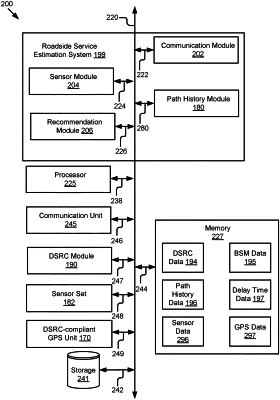| CPC G06Q 30/0202 (2013.01) [G07C 5/008 (2013.01); H04W 4/06 (2013.01); H04W 4/80 (2018.02); G06Q 50/30 (2013.01)] | 20 Claims |

|
1. A method comprising:
creating, by a first onboard vehicle computer system of a first vehicle, a wireless message that includes path history data, wherein the path history data describes a rate of travel for the first vehicle present in a queue of a drive-through business that provides a roadside service and a lane of travel for the first vehicle within the queue based at least in part on global positioning data retrieved by a Global Positioning System unit wherein the global positioning data describes a location of the first vehicle with a lane-level precision at two or more different points in time so that the path history data has the lane-level precision, wherein the drive-through business includes one or more lanes and the lane-level precision is at least half a width of at least one of the lanes;
determining a length of the drive-through;
estimating by the first onboard vehicle computer system, based on the rate of travel, the lane of travel, and the length of the queue, delay time data describing (1) a first number of vehicles in front of the first vehicle in the queue of the drive-through to receive the roadside service and (2) a second number of vehicles behind the first vehicle in the queue to receive the roadside service; and
transmitting a wireless message including the delay time data to a second vehicle that is not present in the queue so that a second onboard vehicle computer of the second vehicle is operable to provide a recommendation about the queue wherein the recommendation is based on the delay time data included in the wireless message so that the recommendation is based at least in part on the lane-level precision of the path history data.
|